
- Destinations
- Experiences
- Stay
- What's new
- Celebrating People
- Responsible Tourism
- CampaignsCampaigns
- Subscribe
- Buy Now

Hikers attempting any of Mount Fuji's four main trails will be charged an entry fee of JPY 4,000 (approximately INR 2,280) this summer after local authorities passed a bill on Monday.
A record influx of foreign tourists to Japan has sparked alarm about overcrowding on the nation's highest mountain, a once-peaceful pilgrimage site.
Last year, Yamanashi prefecture introduced a JPY 2,000 (approximately INR 1,140) entry fee plus an optional donation for the active volcano's most popular hiking route, the Yoshida Trail. Officials concerned about safety and environmental damage on Mount Fuji's majestic slopes also introduced a cap on daily entries and online reservations for the trail.
The Yoshida Trail fee will be doubled for this year's July-September climbing season while neighbouring Shizuoka prefecture passed a bill on Monday to charge JPY 4,000 (approximately INR 2,280) for its three previously free trails.
Thanks in part to the new restrictions, the number of climbers who tackled Mount Fuji declined to 204,316 last year, from 221,322 in 2023, Environment Ministry data showed.
Although climber numbers continue to be eclipsed by pre-COVID-19 pandemic levels, “2,00,000 hikers is still huge,” Natsuko Sodeyama, a Shizuoka prefecture official, said. “There is no other mountain in Japan that attracts that many people in the span of just over two months. So some restrictions are necessary to ensure their safety.”
Mount Fuji is covered in snow for most of the year, but during the summer hiking season many trudge up its steep, rocky slopes through the night to see the sunrise.
The symmetrical mountain has been immortalised in countless artworks, including Hokusai's “Great Wave off Kanagawa.” It last erupted around 300 years ago.
Another measure brought in last year to curb overtourism in a nearby town has also proved effective.
The town of Fujikawaguchiko in Yamanashi prefecture got so fed up with tourist crowds thronging the road near a Lawson's convenience store that they built a huge fence blocking the view of Mount Fuji.
The 20 m long and 2.5 m high fence covered with black mesh prevented tourists from taking selfies with the landmark after incidents of littering, crossing dangerously through busy traffic, ignoring traffic lights, and trespassing into private properties.
The barrier was taken down in August as a precaution when a typhoon was forecast, but authorities decided not to reinstall it as it proved to have been effective. They warned, however, that it could be put back up if tourists return in large numbers.
Furthermore, Kyōto City imposed visitor restrictions in Gion district's private alleys after instances of disrespectful behaviour, such as photography on private roads.
(With inputs from multiple news reports)
